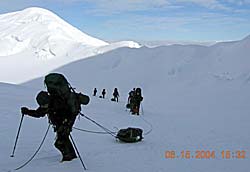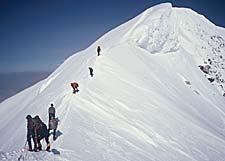Surgeon scales a giant
An orthopedist braves storms and snow to reach the summit of Mt. McKinley in Alaska.
Courtesy of Robert Hottentot |
It takes a single-minded focus to perform complex orthopedic surgical procedures. But few surgeons use this same determination to overcome subzero temperatures, thin air and treacherous terrain to reach the top of Mt. McKinley.
Robert C.G. Hottentot, DO, applied the same resolve used to tackle tough cases in practice to climb one of the highest natural structures in the world. He embarked on a three-week journey to the summit of Mt. McKinley — Denali. Located in Alaska and reaching 20,320 ft high, Denali remains the highest point in North America. The Athabascan name of the summit translates to “the high one” and since 1932, more than 90 people have died on the trek. At the time of his June 2004 climb, Hottentot, formerly with Pine Tree Orthopaedics, was 64 years old.
His long and dangerous trip to Denali started with a three-day wait on an airstrip. Poor visibility stranded Hottentot and his seven-member team plus three guides in Talkeetna, a town that is 800 ft above sea level, he told Orthopedics Today. Finally, a plane flew the crew to base camp. Located at 7000 ft, Hottentot began his journey carrying more than 100 pounds and traveling at night. Hottentot climbed the mountain in the summer, when there is 24 hours of daylight. “The snow conditions are better for travel at night than in the daytime, when the sun shines and the snow is soft and it’s warm,” he said.
A 60° rock wall on fixed ropes
“We would probably leave at 1 a.m. and climb for probably five or six hours until we got to our next destination,” Hottentot said. At each stop the team spent two hours setting up camp. The task included pitching tents and sawing blocks of snow to construct five-foot “snow walls” to protect the camp from fierce winds. Around 13,000 ft, Hottentot’s group encountered snowstorms, which deposited two to three feet of new snow a night.
At 15,000 ft, his team scaled Headwall — a 60· rock wall — carrying supplies on fixed ropes. They made several trips up and down the wall to bring all of their provisions. They finally reached High Camp at 17,000 ft.
Although they were scheduled for a full day of rest, the good weather persuaded the team to attempt the summit. The group started the climb at 10 a.m. and reached their long-awaited destination in seven hours. At 20,000 ft the air contains half of the oxygen that it has at sea level, Hottentot said. Therefore, the team quickly began their descent. “We probably spent about an hour on the summit and it was clear and we were all exhausted,” he said. They descended in five hours to high camp and rested for 12 hours.
Three weeks up, 24 hours back
The next morning, Hottentot’s guide told the group that they could make the trek down the mountain in an amazing 24 hours. “We looked at him and we said, ‘You must be crazy,’ ” Hottentot said. The guide lured the group with promises of soft beds, hot meals and showers. “It started to sound better and better because, at that time, we had been eating dry food mixed with hot water and nobody from our group had seen a shower or a toilet for three weeks and we were all pretty wretched,” Hottentot said.
|
The group continued their descent at 10 a.m. and traveled for four hours. “We would all be exhausted and we would put our sleeping bags in the snow, and we would sleep for a couple of hours,” Hottentot said. “[The guides] would melt snow and fix food and then we would go again for three or four hours repeating that,” he said.
“The last few hours we were on the glacier, there was a thunderstorm going on,” Hottentot said. “The crevasses were treacherous and the light was poor. We were all very tired,” he said.
Twenty-four hours later, the group reached base camp. Although the camp had an airstrip, fog and fresh snow had stopped all flights. To get home, the tired mountaineers needed to make a runway. “Now we have 150 people there all eager to go home with their snow shoes on, stamping on the snow to get a mile and a half of snow compacted so that the planes could land,” Hottentot said.
The workers packed enough snow for the planes to arrive and by 10 p.m., the members reached town for their promised warm beds and showers. “I learned that even when you are 64 [years old] … if you take care of yourself, your body can do some pretty amazing things,” Hottentot said.
Scaling heights, reaching goals
Hottentot’s affinity for climbing began in 1998 when a medical school colleague invited him on a Mt. Rainer climb. Since then, he has scaled some of the highest points in the world including the Annapurna sanctuary (14,000 ft), Aconcagua (22,835 ft), Cotopaxi (19,347 ft) and Kilimanjaro (19,340 ft). “I am a big advocate of taking care of yourself,” Hottentot said. “When I started all this, my weight was probably 30 pounds heavier than what I wanted it to be and now my weight is exactly where I want it to be,” he said.
“You know, 50% to 60% of the patients that orthopedic surgeons see in their office are in trouble because of their lifestyle. If you can adjust the lifestyle, … you can eliminate an awful lot of difficulties and/or prevent an awful lot of difficulties,” he said.
To prepare for climbs, Hottentot works out twice a day. His regimen includes cardiovascular exercise in the morning and weight training after work. “In addition to that, on the weekends, we do either daily trips on the mountains here in Maine or I do overnights climbing and backpacking on the Appalachian Trail,” Hottentot said. He also skis cross-country and goes ice climbing in the winter.
For the Denali trip, Hottentot ice climbed carrying a 50-pound backpack while pulling a 50-pound sled. He also practiced rescue and anchoring techniques in sub-zero weather. “I realize that a lot of people will never climb a mountain as I do, but my 20,000-[foot] mountain may be another person’s walk around the block that they haven’t done in a long time or maybe a bike ride for five miles,” Hottentot said. “Any of those things you set for yourself as a goal, and then start working to reach that goal, is an enormously satisfying experience,” he said.
A new challenge
Hottentot retired from his practice last month, but his adventures are far from over. Currently, he is trekking through the Himalayas to conquer Cho Oyu — the sixth highest mountain in the world. “When I stand on top of Cho Oyu, I will be looking at Mt. Everest,” Hottentot said. “That’s what I’m training hard for right now … ,” he said. “When I’m done with your interview, I’m heading for the gym.”


